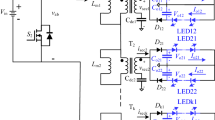Abstract
Traditional control method of LED driver is mainly based on current control mode. Due to the nonlinear characteristics of V–I curve, conventional control methods are more suitable for steady-state control. Meanwhile, the illumination of LEDs is affected by temperature and the distance of the light source. In this paper, a control method with light intensity feedback is proposed to ensure the good performance of illumination. In addition, a fuzzy PID control strategy is employed to improve the LED driver's steady-state accuracy and dynamic performance. The mathematical model of LED driver based on buck converter was built, and the transfer function was derived. An experimental prototype was built to implement the proposed LED control scheme. The light intensity accuracy is limited to 5% when the load varies between 50 and 100%. The simulation model and the experimental prototype verify the feasibility of the LED illumination control method and the optimization of the fuzzy PID control.












Similar content being viewed by others
Data availability
The data that support the findings of this study are available from the corresponding author upon reasonable request.
References
Xunzhai L, Xueshan L, Qun Z et al (2021) Resonant single-switch multi-channel low-ripple output LED driver. Chin J Electro Tech 36(10):2081–2091 (in Chinese)
Liu X, Wei X, Guo L (2023) Indoor passive visible light localization: a case of the novel rake RGB-LED series detector. IEEE Trans Instrum Meas 72:1–13
Zhiyong Q, Yile S, Liang Z et al (2022) Review of ripple compensation control strategy for non-electrolytic capacitor LED driver power supply. J Power Supp 20(3):115–125 (in Chinese)
Li XL, Dong Z, Tse CK (2019) Series-connected current-source-mode multiple-output converters with high step-down ratio and simple control. IEEE Trans Power Electron 34(10):10082–10093
Masomi Z, Yaghoobi M, Kobravi HR (2022) Optimal fuzzy controller design for industrial gear system by gray wolf algorithm. Int. J. Dynam. Control 11:1856–1866 (online)
Shihong X, Pengfei H, Jingwen C et al (2016) Design of DC-DC constant current source for nonlinear LED load. J Shaanxi Univ Sci Tech 34(2):160–164 (in Chinese)
Yanmin W, Yuqing C, Hongwei X (2016) Voltage and current double closed-loop terminal sliding mode control of buck converter. J Electr Mach Control 20(8):92–97 (in Chinese)
Ofoli A, Rubaai A (2006) Real-time implementation of a fuzzy logic controller for switch-mode power-stage DC–DC converters. IEEE Trans Ind Appl 42:1367–1374
Perry AG, Feng G, Liu YF et al (2007) A design method for PI-like fuzzy logic controllers for DC–DC converter. IEEE Trans Ind Electron 54(5):2688–2696
Abbas G, Farooq U, Asad MU (2011) Fuzzy logic based robust pole-placement controller for DC-DC buck converter. IEEE ICICT 2011
Daying S, Shen X, Weifeng S et al (2014) Design and implementation of digital predictive fuzzy PID controller in buck DC–DC converter. J Southeast Univ Nat Sci Ed 44(5):897–901 (in Chinese)
Sureshkumar A, Gunabalan R (2022) Design of robust guaranteed margin stability region pi controller for automotive LED lighting with parameter uncertainty. IEEE Access 10:15657–15670
Kaitun Z, Guohua Z, Shuhan Z et al (2018) Stability analysis of peak I2C-controlled buck LED driver power supply. J Electro Tech 33(8):1793–1801 (in Chinese)
Hassani MJ, Ghoreishy H, Ahmad AA (2020) A high-current 1.5-stage LED driver with current-mode BCM PFC and low-voltage film capacitors. Electr Eng 103(1):23–33
Ramezani-al MR, Emami K, Roozbahani PS (2022) New sliding mode controller design for a DC to DC buck power converter in the presence of matched and mismatched disturbances. Int J Dyn Control 10:1208–1216
Abdelmessih G, Alonso JM, Costa M et al (2020) Fully integrated buck and boost converter as a high-efficient high-power-density off-line LED driver. IEEE Trans Power Electron 35(11):12238–12251
Hongzhu L, Renzhong C, Lei Z et al (2018) Magnetic integrated switch-inductor interleaved parallel buck/boost converter. J Electr Mach Cont 22(6):87–95 (in Chinese)
Saravanan M, Ganesh N (2020) A single-stage soft-switching LED driver based on CLCL resonant converter and BCM circuit for lighting application. Electr Eng 102(2):909–920
Jiho M, Jaeseong L, Khurram J et al (2023) Concurrent current and voltage regulated buck-boost converter for automotive LED matrix headlights. IEEE Trans Power Electron 38(5):6015–6023
Guanfeng D, Huibin Q (2021) Tunnel lighting control system based on vehicle perception and fuzzy PID. Sens Micro 40(2):95–97 (in Chinese)
Yifeng W, Xiaochen W, Lei L et al (2021) Suppression method of LED current oscillation for PWM Shunt dimming driver under high dimming frequency. Chin J Electro Tech 36(S01):283–291 (in Chinese)
Author information
Authors and Affiliations
Contributions
LG contributed to the investigation, supervision and writing—review and editing. WL was involved in the methodology and writing—original draft preparation. LC assisted in the data collation.
Corresponding author
Ethics declarations
Conflict of interest
The authors declare that they have no conflict of interest.
Rights and permissions
Springer Nature or its licensor (e.g. a society or other partner) holds exclusive rights to this article under a publishing agreement with the author(s) or other rightsholder(s); author self-archiving of the accepted manuscript version of this article is solely governed by the terms of such publishing agreement and applicable law.
About this article
Cite this article
Li, G., Wang, L. & Li, C. Design and implementation of control method for LED driver based on light intensity feedback. Int. J. Dynam. Control 12, 1427–1435 (2024). https://doi.org/10.1007/s40435-023-01283-6
Received:
Revised:
Accepted:
Published:
Issue Date:
DOI: https://doi.org/10.1007/s40435-023-01283-6




